The Wood We Work With
Understanding Indian hardwoods and their unique properties
We use three main hardwoods from South India. Each type has specific grain patterns, density, and carving characteristics. Our suppliers in Karnataka and Kerala provide certified wood from sustainable forestry operations. Arjun Kumar inspects every shipment before it enters our workshop yard.
Wood selection affects how furniture looks and how long it lasts. Dense woods resist scratches and dents better. Open-grain woods absorb more finish and develop deeper color over time. We match wood type to furniture purpose based on thirty years of experience.
Teak (Tectona Grandis)
Most Popular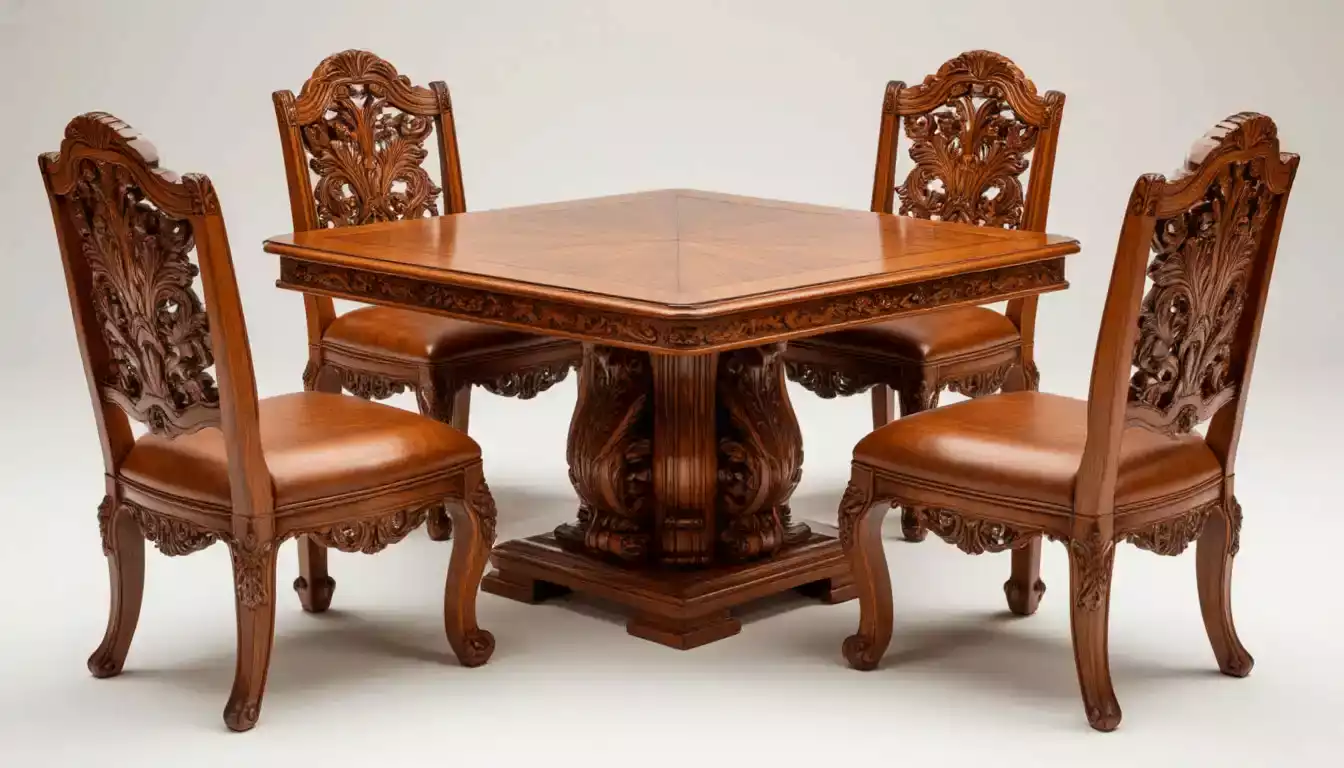
Natural Properties
Teak contains natural oils that repel water and resist termites. The wood density is 655 kilograms per cubic meter. Golden brown color darkens to deep honey over several years. Straight grain makes detailed carving easier.
Historical Use
South Indian temples built with teak from the 12th century still stand today. Palace furniture from the Mysore Kingdom used teak almost exclusively. British colonial administrators shipped teak furniture back to England because it survived tropical humidity.
Current Price
₹4,800 to ₹6,500 per cubic foot depending on grade and grain quality.
Rosewood (Dalbergia Latifolia)
Premium Choice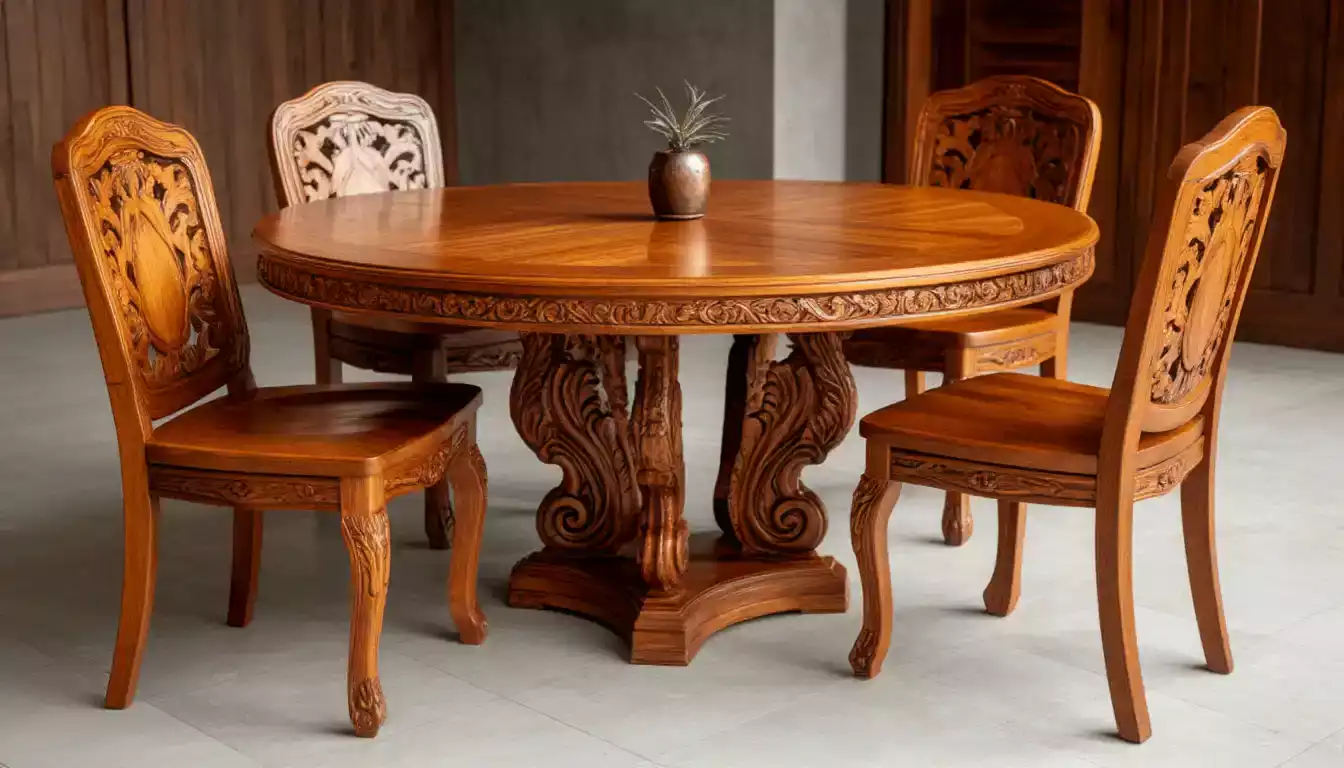
Natural Properties
Indian rosewood has distinctive dark purple streaks through chocolate brown base color. Very dense at 850 kilograms per cubic meter. Takes high polish that lasts decades. Interlocking grain makes it extremely strong but harder to carve.
Historical Use
Mughal emperors commissioned rosewood thrones and ceremonial furniture. Traditional South Indian homes used rosewood for main door frames because thieves could not easily break it. Musical instrument makers prefer rosewood for guitars and sitars.
Current Price
₹8,200 to ₹12,000 per cubic foot due to limited availability and growing restrictions.
Sheesham (Dalbergia Sissoo)
Best Value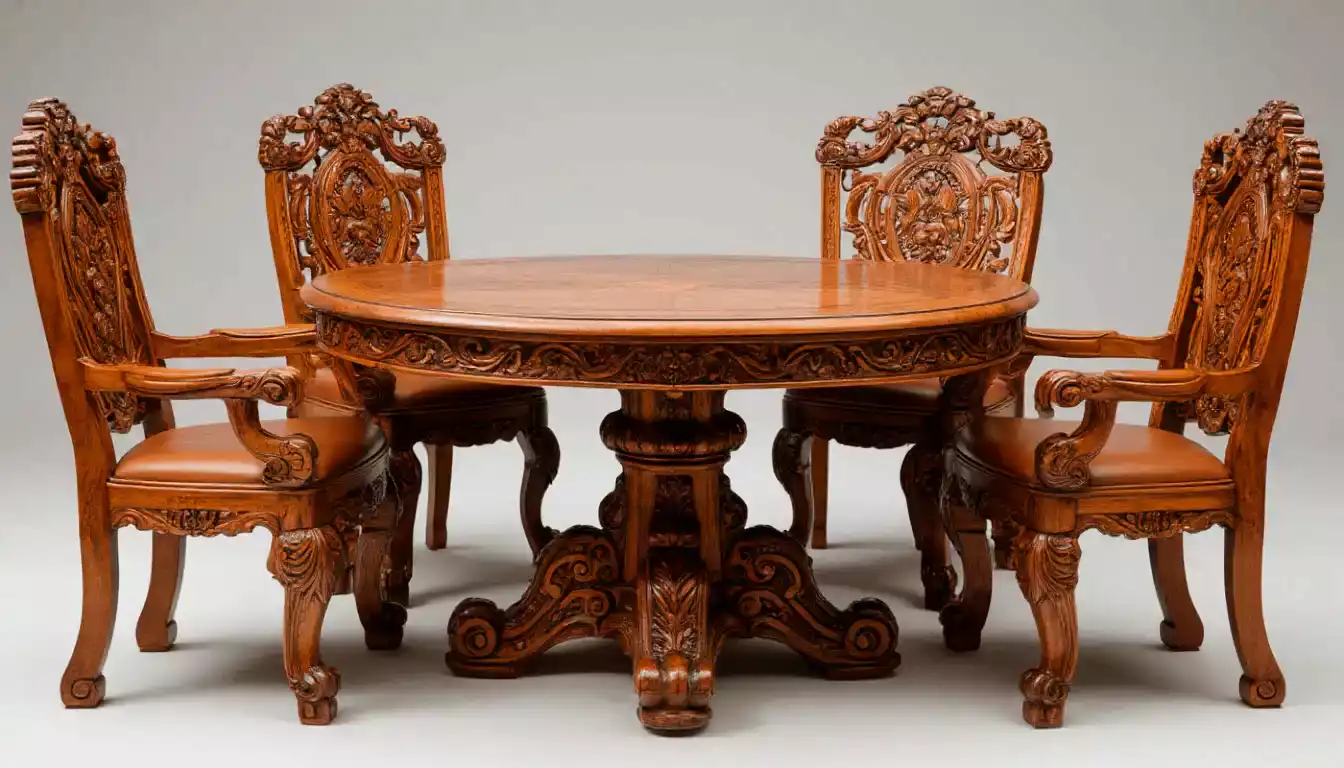
Natural Properties
Medium brown with lighter streaks throughout. Density of 760 kilograms per cubic meter balances strength and workability. Resists warping in high humidity. Carves cleanly with sharp tools and holds fine detail well.
Historical Use
North Indian furniture makers used sheesham for everyday household items for centuries. British colonial railways used sheesham for railway sleepers because it resisted rot. Modern Indian furniture industry relies heavily on sheesham for mid-range quality pieces.
Current Price
₹3,200 to ₹4,800 per cubic foot, making it accessible for most budgets.
Heavy Furniture Makes Families Eat Together More Often
IIT Bombay research shows wood creates 2°C warmer perception
Weight and Permanence
Heavy wooden furniture creates a sense of stability in a room. Our dining tables weigh between 60 and 120 kilograms depending on size. When furniture cannot be easily moved, rooms feel more settled and permanent. This affects how people use the space.
Priya Mehta from Mumbai told us her carved dining set made her family eat together more often. The table felt too substantial to ignore. She stopped using it as a temporary surface for mail and packages. The weight demanded respect.
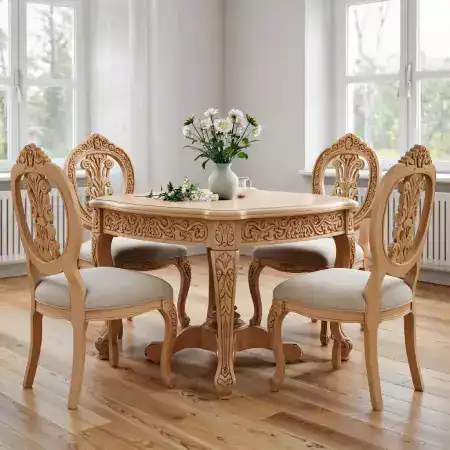
Visual Warmth
Wood tones make rooms feel warmer than metal or glass furniture. This happens because wood absorbs and reflects light differently. Brown and honey colors remind humans of earth and natural materials. Studies from Indian Institute of Technology Bombay measured temperature perception differences of up to 2 degrees Celsius.
Texture Impact
Carved patterns add visual interest that plain surfaces lack. The human eye processes detailed textures as more engaging. Our customers report spending more time in rooms with carved furniture. The texture creates focal points that anchor attention.
Acoustic Properties
Wood absorbs sound differently than hard surfaces. Rooms with wooden furniture sound quieter and feel more intimate. This subtle effect influences conversation volume and room energy. Large wooden pieces reduce echo in rooms with tile or stone floors.
Temple Patterns From Karnataka Used Since 12th Century
Lotus, geometric borders, and peacock designs for contemporary apartments
Certain furniture designs remain relevant across decades because they solve basic human needs well. We focus on patterns and proportions that Indian craftsmen refined over centuries. These designs work in both traditional and contemporary interiors because they follow fundamental principles of proportion and balance.
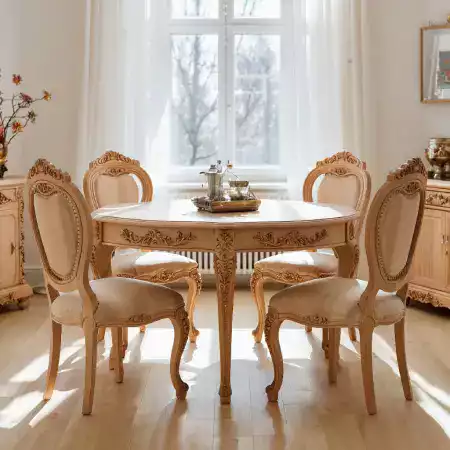
Lotus Motif
The lotus appears in Indian architecture for over two thousand years. We carve it into chair backs and table edges. The flower's symmetry creates natural balance. Works well with both traditional Indian decor and minimalist modern rooms because the pattern is simple enough to read clearly.
Recommended for: Dining chairs, headboards, cabinet doors. Pairs well with solid-colored walls and simple lighting fixtures.
Geometric Borders
Repeating geometric patterns frame furniture edges without overwhelming the design. We use diamond patterns, interlocking squares, and stepped borders. These patterns come from temple architecture in Karnataka. They add visual interest while maintaining clean lines.
Recommended for: Table edges, drawer fronts, mirror frames. Works especially well in apartments with modern architecture.
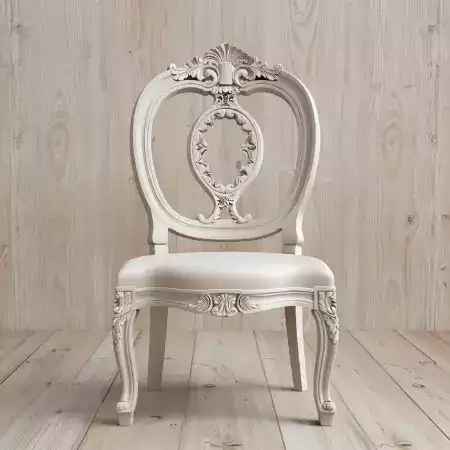
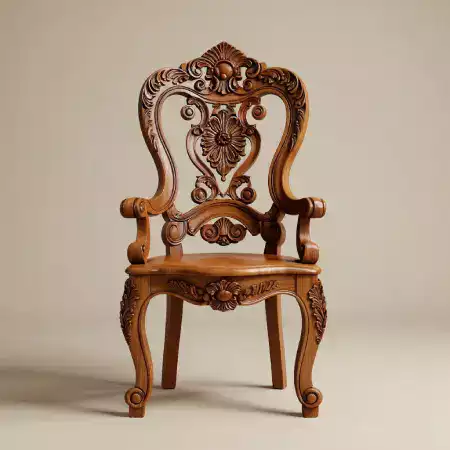
Peacock Design
The peacock is India's national bird and appears frequently in traditional furniture. We stylize the tail feathers into fan patterns. This design adds drama without requiring excessive detail. Best used as a central focal point rather than repeated pattern.
Recommended for: Statement chairs, decorative screens, wall-mounted pieces. Use sparingly for maximum impact.
Side Lighting Shows Carvings Better Than Overhead Fixtures
Use 300-500 lumens warm white bulbs at 2700-3000K temperature
Lighting Considerations
Carved furniture needs proper lighting to show detail. Side lighting from lamps creates shadows that highlight carved patterns. Overhead lighting flattens carvings and makes them disappear visually.
Place floor lamps or table lamps at the same height as carved chair backs or table edges. Use warm white bulbs between 2700K and 3000K. Cool white light makes wood look gray and lifeless. Aim for 300 to 500 lumens per lamp in rooms with wooden furniture.
Dimmer switches let you adjust light intensity for different times of day. Evening lighting can be lower to create intimate atmosphere.
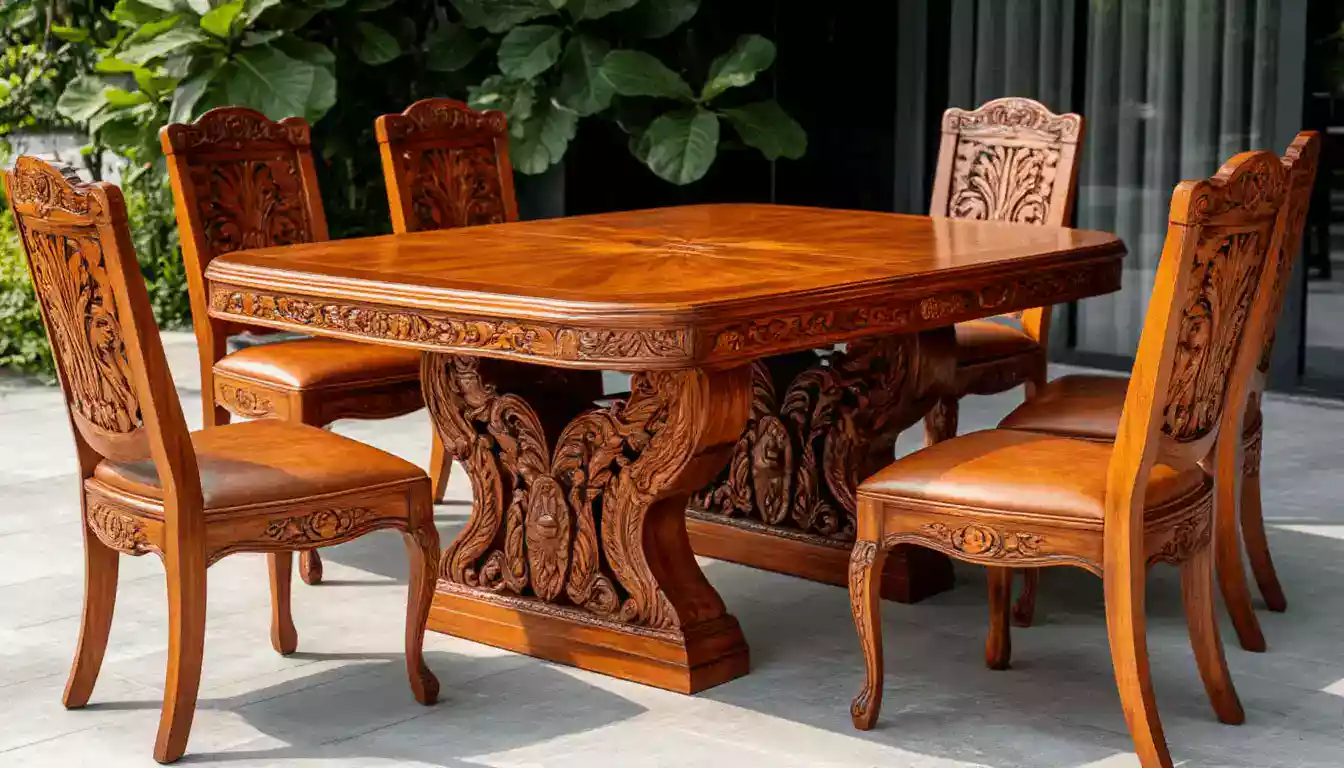
Textile Pairing
Cotton and linen work better than synthetic fabrics with wooden furniture. Natural fibers complement wood textures. Avoid busy patterns that compete with carved details. Solid colors or subtle textures work best. Cushions in cream, rust, or olive green suit most Indian hardwoods.
Wall Colors
Light walls make dark furniture stand out. Off-white, beige, or light gray work well. Avoid pure white which creates too much contrast. Earth tones like terracotta or sand create cohesive look. Test paint samples on walls near furniture before painting entire room.
Decorative Elements
Indoor plants add life without competing with carved furniture. Choose simple pots in clay or ceramic. Metal and glass decorative items provide contrast to wood. Avoid overcrowding surfaces. Let furniture carving be the main decorative element in the room.
Monthly Maintenance Routine
Dust carved areas with soft brush or microfiber cloth. Do not use feather dusters which push dust into carvings.
Wipe smooth surfaces with barely damp cloth. Dry immediately with separate clean cloth.
Apply thin coat of furniture oil once every three months. Use teak oil or Danish oil. Wipe excess after ten minutes.
Check joints for looseness. Contact us if any structural movement occurs. Do not attempt repairs yourself.
Arjun Kumar Answers Your Wood Selection Questions
Which wood suits coastal humidity? Will teak or rosewood work better for your dining room? How often should you oil furniture in Bangalore climate? Get answers from someone who has worked with Indian hardwoods for twenty-five years. No charge for consultation.
Wood type recommendations based on your climate and usage
Carving pattern suggestions for your interior style
Maintenance schedules customized to your furniture pieces
Room layout advice to showcase carved furniture properly
Workshop Location
Church St, opposite StarBucks, near Mahatma Gandhi Road, Haridevpur, Shanthala Nagar, Ashok Nagar, Bengaluru, Karnataka
Open Monday to Saturday
9:00 AM to 6:00 PM
Get Directions